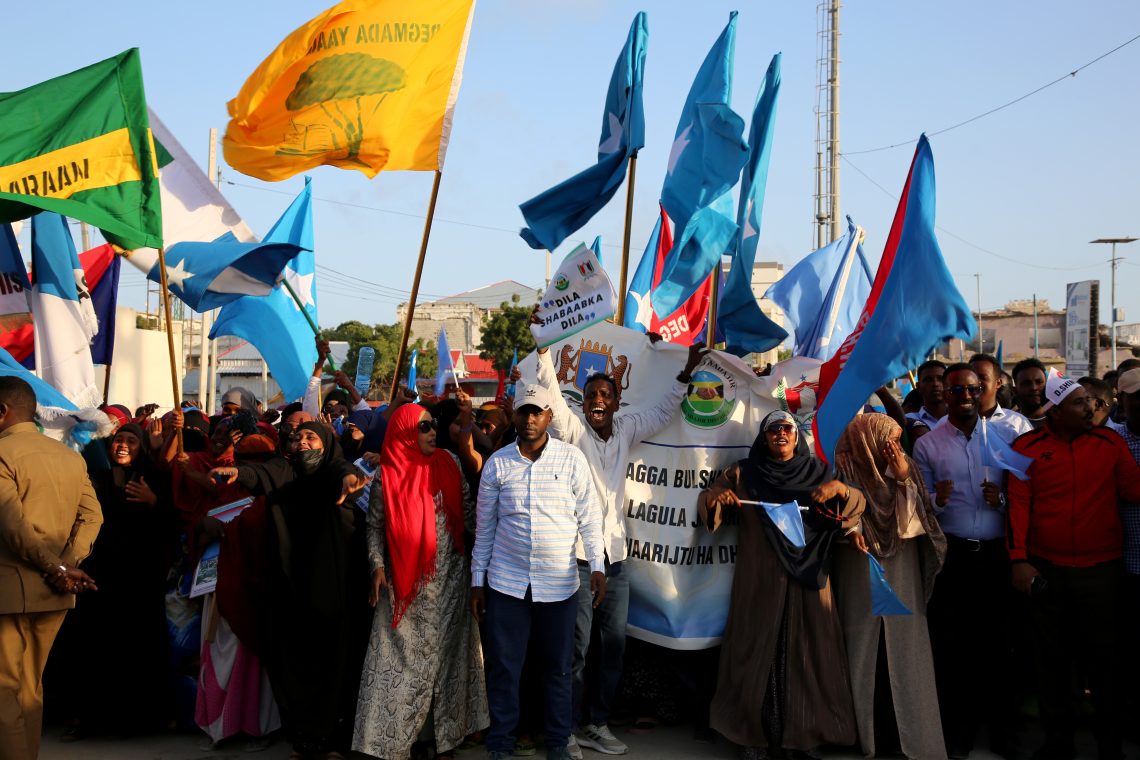Somalia at a critical juncture
Joining the EAC could usher in a new era of growth for Somalia, but a resurgence of violence may compromise new opportunities.

In a nutshell
- Somalia has seen improvement under President Mohamud
- The withdrawal of African Union forces will test this progress
- New ECA membership could put the country on a path to growth
After several postponements, Somalia held indirect presidential elections in May 2022. Members of the parliament elected Hassan Sheikh Mohamud, renewing hopes for stabilization. The modest progress that followed the election then paved the way for the country’s accession to the East African Community (EAC) in December 2023 after years of lobbying.
During the tenure of the previous president, Mohamed Abdullahi Mohamed, the relationship between the federal states and the central government deteriorated, and interactions with the African Union became strained. However, since 2022, Somalia has shown signs of transitioning from a failed to a fragile state. This change is attributed to partial success in curbing the militant Islamist group al-Shabaab; improved relations between the federal government, regional entities and clans; and strides made in institutionalizing power. The new president’s effective “nomad diplomacy” has allowed him to benefit from a clan rebellion against al-Shabaab, which has been challenging the sovereignty of the Somali state for the past two decades.
However, despite massive funding and diplomatic efforts, the political, economic and security outlook remains fragile. Membership in the EAC may bring much needed opportunities on the economic front. But tangible gains will depend on the country’s capacity to address longstanding challenges, including tensions over the federal model, intra-elite conflicts and the threat posed by al-Shabaab.
Political and security hurdles
While perhaps less visible than terrorist violence, uncertainty regarding Somalia’s political system could prove a major stumbling block. Relations between the government and federal states will be defined in the upcoming constitution, but the negotiation process is expected to be tense.
The question of Somaliland, which demands international recognition as an independent and sovereign state, is also sensitive, as it clashes with President Mohamud’s one-Somalia policy. In February 2023, violence erupted in the disputed city of Las Anod between Somaliland forces and local militias from the semi-autonomous Somali region of Puntland. The recent offer by Ugandan President Yoweri Museveni to mediate unification talks was promptly rejected by the government of Somaliland. The situation is also contentious in Washington, with the Biden administration pushing for the one-Somalia policy, and the U.S. Congress calling for a security partnership with Somaliland.
Facts & figures
Reforming the security sector poses another significant challenge for Somalia. Sovereignty requires a monopoly on the legal use of force, yet the Somali government continues to rely heavily on external military support. In 2022, after 15 years, the African Union Mission in Somalia (AMISOM) became the African Union Transition Mission in Somalia (ATMIS). The complete pullout of troops was initially planned for the end of 2024. Following a request from Somalia and other East African nations involved in the mission, the United Nations Security Council agreed to delay ATMIS’s withdrawal by three months.
In 2022, U.S. President Joe Biden also ordered the redeployment of 450 American troops into Somalia. Besides troops on the ground, the U.S. provides intelligence and training, and has conducted airstrikes against al-Shabaab.
Al-Shabaab continues to destabilize Somalia. The 2023 Global Terrorism Index lists the organization as one of the world’s deadliest. The group is linked to al-Qaeda and originated from the Islamic Courts Union (ICU). It gained momentum when Ethiopia, backed by the U.S., intervened in Somalia, displacing the ICU – which had brought a measure of stability – and established the Transitional Federal Government. Since this intervention, al-Shabaab maintains that Somalia is under foreign occupation. Recent uprisings by local clan militias have led to some territorial gains against al-Shabaab.
Weak economic prospects
Somalia struggles with persistent chronic poverty, weak economic prospects and high corruption levels. More than 60 percent of the population is under the age of 25, and 70 percent earns less than $2.15 a day. Poverty and food insecurity levels are higher in rural areas. According to the World Food Programme, one in every four Somalis face food insecurity.
The government received debt relief from the IMF at the Heavily Indebted Poor Countries Completion Point in December 2023, and was also granted about $100 million over three years under the Extended Credit Facility. The Somali economy, like its security infrastructure, relies heavily on foreign financial assistance. Decades of external intervention have created economic distortions and opportunities for rent seeking, which have fueled corruption across several sectors. According to the 2022 Corruption Perceptions Index, Somalia is the most corrupt country in the world.
Joining the EAC: Opportunities and risks
Somalia is in a strategic location at the intersection of the Red Sea and the Indian Ocean, along important trade corridors and in a region where several countries are competing to establish military bases.
President Mohamud has managed to regain Washington’s attention, and is forging closer relations with neighbors in the Horn of Africa. Military cooperation has intensified with Turkey as well as the United Arab Emirates, Somalia’s main ally in the Gulf.
The EAC, inspired by the European Union model, has ambitious plans. It wants to reach ten members by 2025 and aims to deepen coordination between member states on foreign policy, security, economy and trade. These efforts are complicated by the prevalence of conflicts throughout the region. Still, the proxy war between Rwanda and the Democratic Republic of Congo did not dissuade the EAC from accepting the DRC and deploying a regional force in the east of that country. After this daring move in Africa’s Great Lakes Region and following the recent accession of Somalia as its eighth member, the organization aims to expand its presence in the Horn by adding Ethiopia and Djibouti.
More by Teresa Nogueira Pinto
Deepening dysfunction in Zimbabwe
Debt-crushed Ghana is turning volatile
For the EAC, this enlargement could allow it to capitalize on the opportunities provided by the African Continental Free Trade Area (AfCFTA). For Somalia, joining the EAC more than a decade after presenting its first bid not only increases its regional leverage but also provides economic opportunities. Entering a customs union and engaging in open trade could bring much needed growth, reduce food insecurity and allow the country to leverage its strategic position (including a 3,300-kilometer coastline) along trade routes.
Nevertheless, enlargement brings the risk of reducing cohesion and compromising decision-making capacity, not least because of geopolitical tensions between EAC member states. Moreover, given the presence of al-Shabaab in Somalia and its capacity to conduct attacks in neighboring countries (including Kenya), the exemption from visa requirements granted to EAC countries may bring additional security challenges. The lack of functional institutions, legal structures and connecting infrastructures in Somalia reduces the likelihood of growth and stabilization through trade.
Scenarios
Now that Somalia has joined the EAC, there are hopes that the country may finally enter a phase of stabilization and growth. However, despite a peaceful transfer of power and advances in the containment of al-Shabaab, the fragile security outlook could still derail this progress.
Most likely: Long and bumpy road toward stabilization
Given the fragility of the army, the withdrawal of ATMIS may cause a security vacuum. Its departure is expected to coincide with negotiations regarding unresolved constitutional issues, namely relations between the government and federal states and a transition to universal suffrage from the current clan-based system.
The first direct elections will likely test the limits of Somali institutions. Setbacks seem inevitable. However, Somalia’s strategic relevance combined with support from international financial institutions, reengagement with regional neighbors and opportunities provided by joining the EAC could provide incentives for decision-makers to find viable solutions.
Moderately likely: Protracted violence
Al-Shabaab retains important strategic advantages. Unlike the Somali government, it can adapt its strategy (including its financing) to evolving circumstances, including territorial losses. The group was inspired by the Taliban’s victory in Afghanistan and has stated that it “must gather and offer everything [it] can” to support Palestinians fighting in Gaza.
Despite some territorial gains, the government has not been able to establish an effective presence in liberated areas. In these impoverished areas, the only thing preventing an al-Shabaab comeback is the presence of foreign forces.
Less likely: Return to war
With Ethiopia still unstable and civil war in Sudan, a spillover of violence remains a possibility. Moreover, political tensions between the Somali government and the semi-autonomous region of Puntland could lead to armed clashes. The ongoing conflict in Las Anod, in which Somaliland and Puntland forces oppose one another, could also escalate, leading to clan fighting. And as the process of implementing constitutional changes nears completion, the risk of political tensions increases. Further destabilization would benefit al-Shabaab and could spark a new war.
For industry-specific scenarios and bespoke geopolitical intelligence, contact us and we will provide you with more information about our advisory services.









